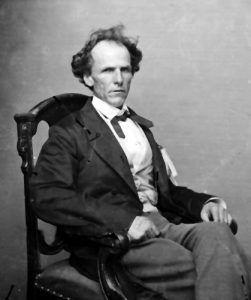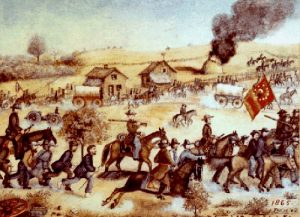
Civil War in Kansas.
The first meeting in Bourbon County, Kansas, which had for its object the discussion of questions likely to grow out of the gigantic war that was then impending, was held on March 13, 1861. Upon the invitation of many leading citizens of Fort Scott, General James Lane was present and delivered an address. He advocated the cultivation of friendly relations between Missouri and Kansas. A large number of citizens of the former State were present.

James Lane
The next meeting of the kind was held at Barnesville on March 20. A series of resolutions was reported to the meeting, which was conservative and favoring State’s Rights. General James Lane addressed this meeting, expressing similar sentiments to those he delivered the week before at Fort Scott.
These meetings occurred before the firing on Fort Sumter, South Carolina, and were comparatively but moderate affairs. After the Civil War began with the bombardment of a United States fortress, the thrill of fiery indignation was felt as keenly in Kansas as anywhere in the Union. On Thursday night, April 24, a Union demonstration occurred in Fort Scott, which was the largest that the city had ever seen up to that time and was unsurpassable in enthusiasm and unanimity. Past party difficulties were forgotten, patriotic songs were sung, patriotic addresses delivered, and the wildest and heartiest applause greeted every expression and person who was in favor of the Union. It was a demonstration in which Fort Scott and Bourbon County, and every true and loyal Kansan and American may always feel the greatest pride.
In the latter part of April, two companies of volunteers were formed on Drywood, under Captains Boring and Brown, and on May 1, two companies were formed in Fort Scott. The officers of one company were Captain Charles W. Blair, Lieutenants A. R. Allison, R. L. Phillips, and Charles Bull. Of the other company — Captain A. McDonald; Lieutenants Charles Dimon, William Gallaher, and A. F. Bicking. These two companies were a few weeks afterward consolidated under C. W. Blair, Captain, and W. C. Ranson, C. O. Judson and A. R. Allison, Lieutenants. After consolidation, the total number of members in this company was 63. It left for Lawrence soon afterward, where it was to be armed, uniformed, and mustered into the service of the Government. But after marching to Lawrence — where Captain Blair was promoted to the Lieutenant Colonelcy of the Second Kansas Regiment, and Lieutenant Ransom elected Captain — and then to Wyandotte, preparatory to crossing to Kansas City to be mustered in, the patriotic fervor of three-fourths of the members of the company had so far subsided, that this number backed squarely out and counter-marched for home May 19, 1861, so that the company as such was never mustered in.
Early this month, a company was organized on Lightning Creek with John T. McWhirt, Captain Roswell Seeley, John Tully, and John F. Gates, Lieutenants. The company was initially named the “Lightning Guards.” Some company members preferred the name “Lightning Blues,” but the majority, fearing this name might be mistaken for “Blue Lightning,” chose the former name.
Captain Blair’s company, whose first term of service was so brief, was named “Frontier Guard No. 1.” Frontier Guard No. 2 was organized with A. McDonald, Captain. Upon his resignation, W. T. Campbell was elected Captain, the Lieutenants being S. B. Gordon, C. O. Judson and John F. White. These two companies had a parade on July 4, inviting all the other companies to participate that had been organized in the county. The Drywood Company, under Captain Boring, and the Mill Creek Company, under Captain Hall, responded.
On July 5, a battle was fought at Carthage, Missouri, which greatly alarmed and disturbed the citizens in the southeastern part of the county. Many families left their homes, apprehensive of an attack from the rebel forces. Shortly after this alarm, General Lyon authorized Captains W. C. Ransom and W. T. Campbell to raise 100 men to act as Home Guards. Afterward, another company was authorized, and thus, there were three companies of Bourbon County Home Guards, all of which went into camp at Fort Scott. These three companies were infantry; afterward, a cavalry company was raised, and the four companies were the origin of the Sixth Kansas, with the following officers: Major W. R. Judson; Captains W. C. Ransom, W. T. Campbell, Z. Gower, and L. R. Jewell, of Companies A, B, C, and D, respectively. The activity and proximity of the war in Missouri led General Lane to order a considerable number of troops to Fort Scott toward the latter part of August. Under Colonel James Montgomery, five companies of the Third Regiment arrived on the 20th from Mound City, and other troops arrived until the aggregate number was about 2,000.
Many Osage Indians also arrived about this time and offered their services to the Government. This was now the headquarters for General Lane’s Division, which rapidly increased in size and rapidly improved in discipline and appointments. Two companies of Colonel Johnson’s Fifth Kansas were also stationed at Barnesville. Confederate General Rains, with 14,000 men, was operating in Missouri and contemplated an attack on Southern Kansas. September 1, he approached within ten miles of Fort Scott, drove in Lane’s pickets, and stole several mules. Until this was done, his presence was not suspected. Colonel Johnson made immediate pursuit but inflicted upon them only the small loss of two or three killed.
All the troops in the vicinity were then concentrated at Fort Scott, preparatory to its defense against an expected attack, and a force of 500 cavalry with one mounted howitzer was sent out to reconnoiter. This force met the enemy’s pickets five miles west of Drywood and drove them back across Drywood Creek to camp. Quite a severe battle was fought until the Union troops exhausted their ammunition and retreated in good order toward Fort Scott. The infantry was stationed on the heights east of the city to receive the rebels in case the anticipated attacks were made, maintaining their position until the darkness of the night and the raging of a heavy thunderstorm rendered it highly improbable that an attack would be made. General Rains’ force was much superior to that of General Lane, which made General Lane apprehensive of the results of a general engagement. He, therefore, led the infantry back to Fort Lincoln on the Little Osage River, 30 miles northward, leaving the cavalry in Fort Scott with orders to defend the city to the last and then burn it rather than let it fall into the enemy’s hands. Fort Scott was thus left practically without defense. The citizens almost entirely deserted it. Only four women dared to remain. These were Mrs. H. T. Wilson, Mrs. William Smith, Mrs. J. S., and Miss Sallie Miller. They determined to remain until their feet were guided in their flight by the light from their burning homes.
A few days after, the rebel forces beat a precipitate retreat toward Independence, pursued from Fort Lincoln to Pappinsville by Colonels Johnson and Jennison, who returned with 200 cattle and several “contraband.”
The removal of the more significant part of the troops from Fort Scott, at a time when that city was menaced by a rebel force considerably more significant than General Lane’s whole command, was a most remarkable piece of strategy on the part of that most remarkable of men and is explained by his enemies on the ground that he had more solicitude for his safety than for the safety of the town.
Notwithstanding numerous efforts to remove the base of supplies from Fort Scott to Fort Lincoln, Mound City, and Humboldt, none of them succeeded. When the troops were paid off, business was lively in the former place, and when on about March 1, 1862, on account of the advance of the rebel armies into Northwest Arkansas, a considerable military force, under Colonel Deitzler, consisting of the First, Fifth and Sixth Kansas, the Ninth, Twelfth and Thirteenth Wisconsin, the Second Ohio Cavalry, and the Second Indiana Battery, was stationed there, money was still more plenty (sic) and times still more improved. During March, Lieutenant Strong of the Second Ohio Volunteer Cavalry built a strong and handsome bridge across the Marmaton River for the convenience of Government trains. This bridge was swept away about April 20 by a tremendous flood, the waters rising fifteen feet above the bridge.
Lieutenant Colonel Jewell, Sixth Kansas, was appointed Post Commander at Fort Scott on June 1, 1862. Lieutenant Colonel Blair of the Second Kansas raised a battery of artillery in Bourbon County in August. This was the Second Kansas Battery, and when completed, was officered as follows: C. W. Blair, Commanding Officer; First Lieutenants, E. A. Smith and D. C. Knowles; Second Lieutenants, A. G. Clark and A. Wilson. Soon afterward, Lieutenant Colonel Blair was commissioned Brigadier General, and in 1863, succeeded to the command of the post and remained in command until the close of the war.
Several forts were erected in Fort Scott during the war: Fort Henning, on Birch Street, between Jones and Judson; Fort Blair, on Locust Street, between Main Street and Scott Avenue; and Fort Insley, north of the Plaza.
The most exciting incident of the war in Bourbon County after the battle of Drywood and the retreat of General Lane to Fort Lincoln was the passage of Confederate General Sterling Price’s army through the eastern part of it in October 1864. Before the result of the battle of Mine Creek was known, the people of Fort Scott were hourly expecting Price’s forces to march into their city and raze it to the ground. Any speculative individual with a few dollars could have bought and paid for the whole town. It was the darkest hour its people had ever seen. But that evening, Colonel Moonlight, who had kept on Price’s right flank from Mound City, arrived with the most welcome news that Price had been defeated and that General Blair, with his command, would enter the city within an hour. Everybody was overjoyed, and a feast was soon begun for the tired and hungry soldiers. The next day saw the entrance into the city of a part of Sterling Price’s army as prisoners — Major General Marmaduke, Brigadier General Cabell, Colonel Slemmens, and about one thousand private soldiers. Had Price entered the city, he could easily have destroyed it. This was the last actual danger Fort Scott was ever in from rebel soldiers.
As Price’s army crossed the valley of the Little Osage River, it committed numerous murders and robberies. At Fort Lincoln, they killed Andrew Stevens and, further down the river, Mr. Goodall and Mr. Miller. They burned the houses of Richard Spafford and Mr. Hopkins, robbed many families of all their money, provisions, clothing, and bed clothing, and stole what horses they could find.
Bourbon County made an honorable record in the war. It furnished its full proportion of soldiers and was fifth in rank regarding the number of her citizens that entered the militia; the number enrolled was 676, while the number organized was 550. The county furnished one Brigadier General — C. W. Blair; one Colonel — W. R. Judson; one Lieutenant Colonel — Lewis R. Jewell, in the volunteer service and the militia; two Colonels — J. Stadden and George P. Eaves.
Once the war was over, steady progress was made in the county.
©Kathy Alexander/Legends of Kansas, October 2023.
Also See:
Bleeding Kansas & the Missouri Border War
Fort Scott Military Post – National Historic Site
Source – Cutler, William G; History of Kansas; A. T. Andreas, Chicago, IL, 1883.

